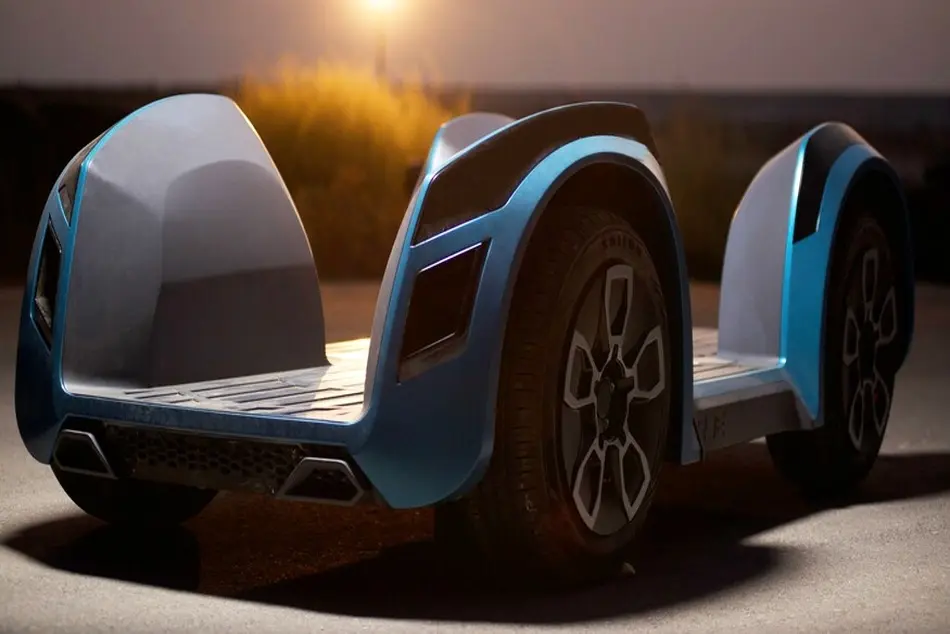Is REE Automotive's Skateboard Chassis the Future of Commercial EVs?
The company's REEboards and REEcorners are due to underpin future commercial EVs.

The company's REEboards and REEcorners are due to underpin future commercial EVs.
Sure, you could always buy a prefab skateboard from Element or Zero, but the cool kids pick their ideal size deck and then select custom trucks and wheels to suit. Tel-Aviv-based REE Automotive reckons it should be just as easy to build your electric mobility as a service (MaaS) shuttle or delivery van. At CES 2021, the company showed off its electric skateboard chassis concept comprised of its patented REEboards and REEcorners.
REEboards—Backbone Of The Electric Skateboard Chassis
REEboards are way larger but only slightly more complicated than the bent plywood of an analog skateboard. In addition to providing the structural basis for the finished vehicle, the board houses a battery sized for its intended duty cycle, along with most power electronics and the wiring needed to distribute the power, as well as the steer-, brake-, and accelerate-by-wire commands, to the corners.

REEcorners: The Trucks And Wheels Of The REEboard
REEcorners mount to the REEboard and house the motor, brake, spring, damper, wheel, and tire all within the envelope of the modest-sized wheel well. The design of these corners can vary with the fitment, but examples displayed include angled coil-over-shock designs, typical disc brakes (with electric actuation), and the option of an electric motor. Obviously, any corner can be driven or not as desired, and naturally, the size and strength of the motor, brakes, springs, and shocks can be tailored to suit a range of different projected gross-vehicle weights. The suspensions are all completely mechanical, as air or hydraulic connections unnecessarily complicate the REEboard design.
Obviously, these fully plug-and-play REEcorners can be operated by a computer or by a person manning controls, so REE Automotive's e-chassis solution is ready for all levels of autonomy, from level 2 assist to full-on robotaxi or delivery pod. Benefits REE claims for its platform include: complete freedom of body design, fast launch cycles, highest load capacity in the smallest footprint, battery capability ranging from 48 to 800 volts, minimal downtime for maintenance, and over-the-air updates with artificial intelligence providing preventive maintenance.

Ready For Commercial Use
The REEcorners strike this tech-watcher as exceptionally good at being compact, modular, easily assembled, and cost-effective. They do NOT strike me as the ideal way to suspend a sports car, luxury sedan, or SUV. REE Automotive knows this, which is why it is primarily targeting commercial uses.
"We strive to be the blank canvas on top of which partners and customers can build EVs [and] AVs tailored to their exact needs while on the road [toward] a zero-emissions future," Daniel Barel, REE's chief executive officer and co-founder, said. Late last year, the game-changing nature of REE's product was recognized with a BloombergNEF Pioneer award.
Toyota's heavy-truck division, Hino, showed off its FlatFormer delivery concept truck based on the REE platform at the 2019 Tokyo Motor Show. Additionally, REE Automotive signed a memorandum of understanding in late 2020 with Mahindra that aims to produce 250,000 electric commercial vehicles on REE platforms. Furthermore, the company has inked strategic partnerships with Tier 1 companies such as American Axle, NSK, Musashi, Tenneco, KYB, and Iochpe-Maxion. Leaning on this network of partners and customers, REE Automotive tells us to expect the first products rolling on its electric skateboard chassis to appear in 2023.